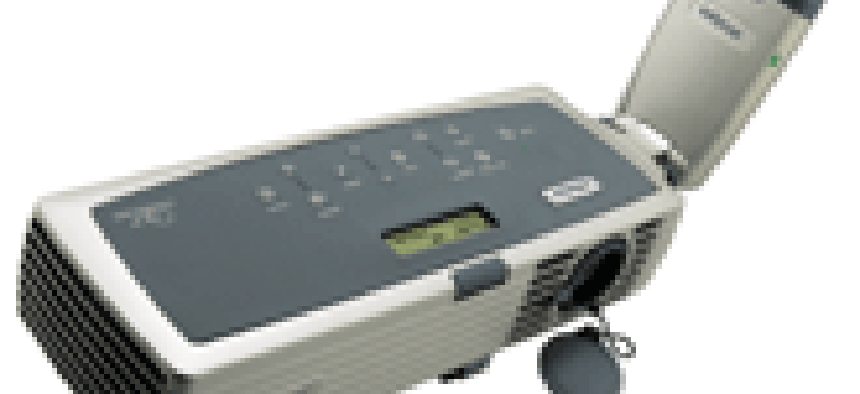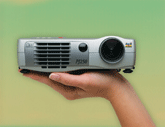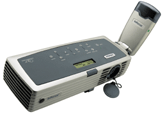Projectors are going small in a big way.In the next five years, 'projector shipments are supposed to triple from 1.7 million units shipped worldwide to 5.2 million,' said Jennifer Gallo, an analyst who covers the projector and flat-panel display markets for International Data Corp. of Framingham, Mass.That's a lot of presentations waiting to be made.There is common sense behind the move: projectors, while being smaller and lighter than they used to be, are finally dipping down in price to near consumer-item status. Epson America Inc., InFocus Corp. and ViewSonic Corp., for example, each have projectors priced at $999. At that figure, it's almost as easy to buy a new projector as it is to spend $400 or so replacing the lamp that's outlived its usefulness in your current behemoth.Such burnouts, by the way, can happen at the most inauspicious times, such as in a recent interactive direct mail exhibit at the Smithsonian Institution's National Postal Museum in Washington. The 'replace the lamp' warning flashed forlornly on a display screen while the crowds strolled by.Lower prices, Gallo said, also mean projectors will move into local Circuit City or Best Buy stores as something to add to a home entertainment system. Why worry about a flat-plasma monitor when a blank wall and a projector can give you 'The Sopranos' like you've never seen them before?The very presence of projectors in consumer electronics stores is, oddly enough, a plus for government buyers: Lower prices benefit such users, too, as does the familiarity such placement brings, said Jeff Klass, vice president for business development at ViewSonic Corp.'The more places companies in general can reach consumers with front projection devices, the more [enterprise] demand there is,' he said.And by making projectors more user-friendly for the home market, enterprise users also are happier: 'The inputs in a projector now are so friendly. Each is color coded to match the input from components such as a DVD player, a VCR, even satellite TV,' Klaas said. Hookups to a portable computer are also no problem, since just about every notebook PC has a VGA or SVGA output jack, and some have additional video connectors.With projectors shrinking in size or price, or both, agencies might re-examine how they use them.Annie Sunseri, government and education marketing and sales manager for InFocus Corp., said less expensive projectors still have quality features'including 3,000-hour bulbs, high video quality and 3,000-lumen output.As a result, projectors could find their way to more departmental users and even workgroups, she said.Along with government purchases for the Microsoft PowerPoint-happy managers in a given department, IDC's Gallo said she believes the new floor for projector prices will have an impact in another market: education.[IMGCAP(2)]'It does affect specific segments such as education, which has budget constraints,' Gallo said. 'They need projectors; they are something they need to educate their students every day. The education sector understands the value of projectors. By making them cheap, you will drive acquisitions.'But a key factor'the cost of lamps for the projectors'is likely to put something of a floor under projector prices.'Lamp technologies are one prohibiting factor in the deteriorating price of projectors,' ViewSonic's Klaas said. Part of the problem, is that lamps are not easily interchangeable from one maker to another. So for now, a $400 lamp is a barrier.That doesn't mean, however, that lamp technologies won't improve in the coming months.'Improvements in terms of the length of projector lamp-life will also be important this year,' said Tamaki Iwamiya, business development manager of Hitachi America Ltd.'s Digital Media Division. In April, Hitachi announced a projector with a lamp that lasts up to 4,000 hours, double that of many standard projectors.Another factor'though impressions are, to say the least, mixed'is the impact networked and wireless technologies will have on projectors.Over the past couple of years, users of Palm Inc. devices and handheld PCs that run the Microsoft Pocket PC operating system have relied on products from Margi Systems Inc. of Fremont, Calif., to store and replay PowerPoint slides on projectors. Users may have had to sacrifice some of the more slick features of their presentation software, but carrying a week's lectures in your shirt pocket instead of on a notebook PC was a powerful incentive.Now, Margi is moving its technology to wireless projectors, cutting deals with firms such as Hewlett-Packard Co. to build the feature into their projectors.Phil Underwood, Margi's vice president of sales, touted having software management features built into a wireless projector.'It gives you the convenience of being able to present wirelessly, and for companies to leverage their wireless infrastructure,' he said. A user can connect point-to-point and be presenting in seconds.The feature also offers collaboration capabilities and the ability to 'freeze' the display screen, letting a wireless presenter check e-mail or do another task during a meeting, though presumably not during the presentation.But at the same time, Underwood concedes his company's wireless product can only display small-frame video and animations, and other companies' wireless systems aren't yet up to full-motion video challenge.Such negatives have left IDC's Gallo, frankly, somewhat underwhelmed: 'With wireless, we're not down with it. You can't do full-motion video with a wireless projector'it has trouble with transitions and sliding titles. You can't just bring a notebook and expect it'll work with a wireless projector.'But optimists remain: Hitachi's Iwamiya said networking will loom large over the projector world.'The networkable and wireless projector markets are beginning to take shape, and [we believe] that next-generation projectors will be able to transfer motion pictures much more naturally, from a PC to the projector,' he said.'This flexibility will not only provide for a better picture but will increase the demand for networked projectors. Eventually, all meeting rooms will have one projector and one PC'both of which will be connected to the LAN.'Regardless of what happens with wireless technology and projectors, there's one factor that will influence projector sales in the near future: size. Borrowing from the late E.F. Schumacher, small really is beautiful.Noted Gallo, 'InFocus is offering the very portable LP120, a personal projector, for $2,799. It's in the shape of a brick; they've overcome the barrier of the salesperson having to carry two bags.'Though priced far above the new, magic $999 price point of the InFocus' X1, ultrasmall, ultralight projectors such as the LP120 offer users far greater freedom and capability in a tiny package. Right now the province of early adopters, small projectors could be the next big thing.
ViewSonic's PJ250 priced at $1,999, is an LCD model that projects at 1,000 lumens and weighs 2.2 pounds.
The InFocus LP120 weighs 1.98 pounds and projects at 1,100 lumens. It's priced at $2,799.








